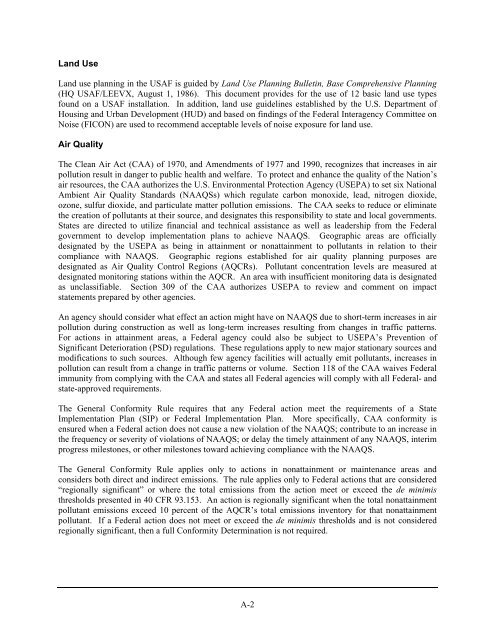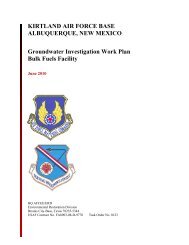Final FONSI and EA for hot cargo pad on Kirtland AFB - Kirtland Air ...
Final FONSI and EA for hot cargo pad on Kirtland AFB - Kirtland Air ...
Final FONSI and EA for hot cargo pad on Kirtland AFB - Kirtland Air ...
Create successful ePaper yourself
Turn your PDF publications into a flip-book with our unique Google optimized e-Paper software.
L<str<strong>on</strong>g>and</str<strong>on</strong>g> Use<br />
L<str<strong>on</strong>g>and</str<strong>on</strong>g> use planning in the USAF is guided by L<str<strong>on</strong>g>and</str<strong>on</strong>g> Use Planning Bulletin, Base Comprehensive Planning<br />
(HQ USAF/LEEVX, August 1, 1986). This document provides <str<strong>on</strong>g>for</str<strong>on</strong>g> the use of 12 basic l<str<strong>on</strong>g>and</str<strong>on</strong>g> use types<br />
found <strong>on</strong> a USAF installati<strong>on</strong>. In additi<strong>on</strong>, l<str<strong>on</strong>g>and</str<strong>on</strong>g> use guidelines established by the U.S. Department of<br />
Housing <str<strong>on</strong>g>and</str<strong>on</strong>g> Urban Development (HUD) <str<strong>on</strong>g>and</str<strong>on</strong>g> based <strong>on</strong> findings of the Federal Interagency Committee <strong>on</strong><br />
Noise (FICON) are used to recommend acceptable levels of noise exposure <str<strong>on</strong>g>for</str<strong>on</strong>g> l<str<strong>on</strong>g>and</str<strong>on</strong>g> use.<br />
<strong>Air</strong> Quality<br />
The Clean <strong>Air</strong> Act (CAA) of 1970, <str<strong>on</strong>g>and</str<strong>on</strong>g> Amendments of 1977 <str<strong>on</strong>g>and</str<strong>on</strong>g> 1990, recognizes that increases in air<br />
polluti<strong>on</strong> result in danger to public health <str<strong>on</strong>g>and</str<strong>on</strong>g> welfare. To protect <str<strong>on</strong>g>and</str<strong>on</strong>g> enhance the quality of the Nati<strong>on</strong>’s<br />
air resources, the CAA authorizes the U.S. Envir<strong>on</strong>mental Protecti<strong>on</strong> Agency (USEPA) to set six Nati<strong>on</strong>al<br />
Ambient <strong>Air</strong> Quality St<str<strong>on</strong>g>and</str<strong>on</strong>g>ards (NAAQSs) which regulate carb<strong>on</strong> m<strong>on</strong>oxide, lead, nitrogen dioxide,<br />
oz<strong>on</strong>e, sulfur dioxide, <str<strong>on</strong>g>and</str<strong>on</strong>g> particulate matter polluti<strong>on</strong> emissi<strong>on</strong>s. The CAA seeks to reduce or eliminate<br />
the creati<strong>on</strong> of pollutants at their source, <str<strong>on</strong>g>and</str<strong>on</strong>g> designates this resp<strong>on</strong>sibility to state <str<strong>on</strong>g>and</str<strong>on</strong>g> local governments.<br />
States are directed to utilize financial <str<strong>on</strong>g>and</str<strong>on</strong>g> technical assistance as well as leadership from the Federal<br />
government to develop implementati<strong>on</strong> plans to achieve NAAQS. Geographic areas are officially<br />
designated by the USEPA as being in attainment or n<strong>on</strong>attainment to pollutants in relati<strong>on</strong> to their<br />
compliance with NAAQS. Geographic regi<strong>on</strong>s established <str<strong>on</strong>g>for</str<strong>on</strong>g> air quality planning purposes are<br />
designated as <strong>Air</strong> Quality C<strong>on</strong>trol Regi<strong>on</strong>s (AQCRs). Pollutant c<strong>on</strong>centrati<strong>on</strong> levels are measured at<br />
designated m<strong>on</strong>itoring stati<strong>on</strong>s within the AQCR. An area with insufficient m<strong>on</strong>itoring data is designated<br />
as unclassifiable. Secti<strong>on</strong> 309 of the CAA authorizes USEPA to review <str<strong>on</strong>g>and</str<strong>on</strong>g> comment <strong>on</strong> impact<br />
statements prepared by other agencies.<br />
An agency should c<strong>on</strong>sider what effect an acti<strong>on</strong> might have <strong>on</strong> NAAQS due to short-term increases in air<br />
polluti<strong>on</strong> during c<strong>on</strong>structi<strong>on</strong> as well as l<strong>on</strong>g-term increases resulting from changes in traffic patterns.<br />
For acti<strong>on</strong>s in attainment areas, a Federal agency could also be subject to USEPA’s Preventi<strong>on</strong> of<br />
Significant Deteriorati<strong>on</strong> (PSD) regulati<strong>on</strong>s. These regulati<strong>on</strong>s apply to new major stati<strong>on</strong>ary sources <str<strong>on</strong>g>and</str<strong>on</strong>g><br />
modificati<strong>on</strong>s to such sources. Although few agency facilities will actually emit pollutants, increases in<br />
polluti<strong>on</strong> can result from a change in traffic patterns or volume. Secti<strong>on</strong> 118 of the CAA waives Federal<br />
immunity from complying with the CAA <str<strong>on</strong>g>and</str<strong>on</strong>g> states all Federal agencies will comply with all Federal- <str<strong>on</strong>g>and</str<strong>on</strong>g><br />
state-approved requirements.<br />
The General C<strong>on</strong><str<strong>on</strong>g>for</str<strong>on</strong>g>mity Rule requires that any Federal acti<strong>on</strong> meet the requirements of a State<br />
Implementati<strong>on</strong> Plan (SIP) or Federal Implementati<strong>on</strong> Plan. More specifically, CAA c<strong>on</strong><str<strong>on</strong>g>for</str<strong>on</strong>g>mity is<br />
ensured when a Federal acti<strong>on</strong> does not cause a new violati<strong>on</strong> of the NAAQS; c<strong>on</strong>tribute to an increase in<br />
the frequency or severity of violati<strong>on</strong>s of NAAQS; or delay the timely attainment of any NAAQS, interim<br />
progress milest<strong>on</strong>es, or other milest<strong>on</strong>es toward achieving compliance with the NAAQS.<br />
The General C<strong>on</strong><str<strong>on</strong>g>for</str<strong>on</strong>g>mity Rule applies <strong>on</strong>ly to acti<strong>on</strong>s in n<strong>on</strong>attainment or maintenance areas <str<strong>on</strong>g>and</str<strong>on</strong>g><br />
c<strong>on</strong>siders both direct <str<strong>on</strong>g>and</str<strong>on</strong>g> indirect emissi<strong>on</strong>s. The rule applies <strong>on</strong>ly to Federal acti<strong>on</strong>s that are c<strong>on</strong>sidered<br />
“regi<strong>on</strong>ally significant” or where the total emissi<strong>on</strong>s from the acti<strong>on</strong> meet or exceed the de minimis<br />
thresholds presented in 40 CFR 93.153. An acti<strong>on</strong> is regi<strong>on</strong>ally significant when the total n<strong>on</strong>attainment<br />
pollutant emissi<strong>on</strong>s exceed 10 percent of the AQCR’s total emissi<strong>on</strong>s inventory <str<strong>on</strong>g>for</str<strong>on</strong>g> that n<strong>on</strong>attainment<br />
pollutant. If a Federal acti<strong>on</strong> does not meet or exceed the de minimis thresholds <str<strong>on</strong>g>and</str<strong>on</strong>g> is not c<strong>on</strong>sidered<br />
regi<strong>on</strong>ally significant, then a full C<strong>on</strong><str<strong>on</strong>g>for</str<strong>on</strong>g>mity Determinati<strong>on</strong> is not required.<br />
A-2
















